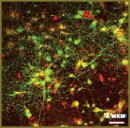
Мультиэлектродные матрицы — новые возможности в исследовании пластичности нейрональной сети
Investigation is dedicated to important problem of the brain neuronal network plasticity mechanism revealing. One of the key moments for that problem solution is a possibility of the functional process noninvasive monitoring in brain at life from a molecular and cellular level to a systemic organization level. Such a possibility is realized in multielectrode systems, used in neurophysiology and characterized by many advantages: a cellular noninvasiveness; a possibility of a simultaneous registration of signals and the cell stimulation; a chronic experiment (months); a possibility of pharmacologic manipulations, including a medicinal screening; a structural and functional neurovisualization at life. A combination of the cell culture with a multielectrode system of registration and a stimulation of the neuron activity permit to simulate in dynamics the different stages of the neuronal chain development. An alteration of that activity pattern, the mechanisms of which are still not clear, takes place depending on a culture age, the cultivation conditions and pharmacologic effects.
The aim of investigation is a study of the hippocamp neuron spontaneous bioelectrical activity appearance conditions in vitro depending on time of development and the cell density in culture.
Materials and Methods. The experiments are made on dissociated cultures of the mouse embryo hippocamp embryonal cells (E18). A combination of the MED64 neuron activity extracellular registration multielectrode system (Alpha MED Sciences, Japan) with the methods of the intracellular calcium alteration visualization at life with a use of a fluorescent stain Oregon Green 488 WARTA-1 and a laser scanning confocal microscope Zeiss LSM510 NLO Duoscan has permitted to investigate in dynamics the different stages of the neuronal network development.
Results. It is established, that a functional activity of culture, registered both at extracellular electrodes MED64 and with a use of a confocal microscopy (the calcic oscillations) compared to the morphologic imaging investigation data, is actually an indicator of forming in a process of the active neuroglial network cultivation. An appearance of the neuron spontaneous activity in a network depends on age and density of the hippocamp cell culture.










